Lifting the Dinnie Stones is a challenge for which strength enthusiasts from all over the world travel to Scotland. Donald Dinnie not only lifted but carried the “Steens” across the Potarch Bridge in 1860—a feat that would not be replicated for more than a century. In 1972, somebody was finally able to do what he had done. Jack Shanks, a police officer from Ireland, became the first person to match Donald Dinnie’s feat. Since then, 226 people have successfully lifted the stones at the time that I am writing this, and it has become a worldwide recognized feat of strength and achievement in the strength community.
In my last article, I shared my experiences and the lessons learned while training to lift the Dinnie Stones. Now let me take you through my training approach for reaching this goal.
The First Steps
The first challenge to overcome is to “prove worthy” for scheduling an attempt to lift the Dinnies Stones in Potarch, Scotland. To do so, you have to “provide evidence of lifting 300kg or more” in a partial deadlift without any lifting aids (see the guidelines here) to “show that the lifter is competent and […] aware of the potential for injury when lifting heavy weights.” Safety and performance are not viewed as opposites, but as the two sides of the same coin.
When I made the decision to start training to “put the wind beneath the stones” in August of 2020, I was doing Pavel Macek’s test program for his Imperial Program Minimum (check out his training log), training kettlebell snatches and the barbell Bent Press four times a week.
A lot has been written about kettlebells and deadlifts and how well kettlebell ballistics translate to the deadlift. But I knew that just doing snatches alone wouldn’t be enough to stimulate sufficient adaptations for expressing the maximal strength needed to lift the Dinnies. As Prof. Nikolay Yakovlev found out: “Training with speed loads without significant strength tension has almost no effect on the myostromin content [a protein which is important for expressing high levels of strength] and, therefore, cannot fully replace strength training.” Since I had such great results with Pavel’s minimalist deadlift routine for Q&D in combination with swings, I decided to apply a similar approach to the rack pull and add it to my routine.
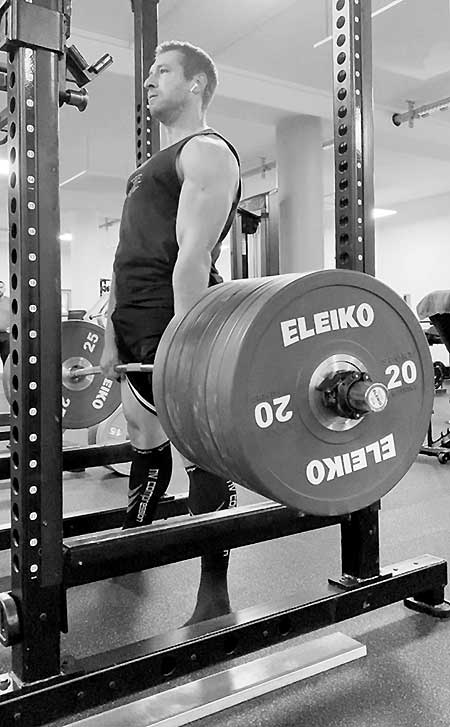
Together with StrongFirst Certified Master Instructor, Jason Marshall, who shared a lot of valuable insights with me from his own training for his successful attempt, I laid out a very simple linear cycle. Once a week I would do rack pulls beginning with five singles and work up to a heavy top set. To allow me to gain momentum, we chose a very conservative progression: starting with 220kg as the top set and increasing it by 5kg from week to week. This got me to 280kg within eleven weeks, but then my progress stalled. I was close, but not there yet. Not being able to break through this point, we decided to switch gears.
Phase 1: General Physical Preparedness—Building the Base
To reach a peak, you must build the appropriate base as a foundation. Since lifting the Dinnie Stones represented a peak higher than anything I had achieved so far, I knew that a corresponding broad and solid foundation was necessary to reach this goal. Inspired by the basic idea behind Jason Marshall’s article, “Chop Wood, Carry Water…Repeat,” I took the chance of testing an experimental program by Pavel, which used a “tactical application” of the principles behind Plan Strong™, in combination with “The Quick and the Dead” where the same principles are applied.
With the goal of keeping this a general physical preparedness (GPP) phase, I chose exercises that would “cover the most ground” and build a general base of strength, not only in the specific angles and ranges necessary for the rack pull and lifting the Dinnie Stones. My exercises of choice were:
- The Zercher Squat and Military Press, according to Pavel’s experimental program.
- Kettlebell Snatches following the Q&D Protocol + Minimalist Deadlift Routine.
- Loaded Carries: Farmer Carries, Zercher Carries, and Get-ups
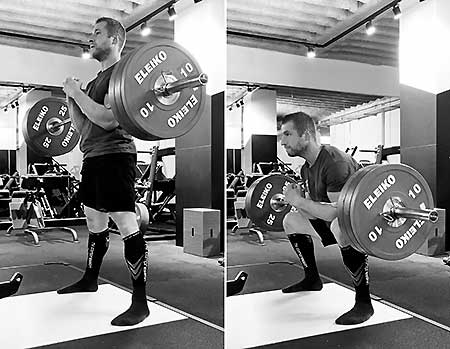
At the beginning of each week, I would determine via die roll:
- The number of training days for the Zercher Squat, Military Press, and Kettlebell Snatch.
- The intensity and total volume for the Zercher Squat and Military Press.
- The total volume and structure of series for the Snatch, adding the minimalist deadlift routine on the corresponding low volume days.
- I added loaded carries to a session based on how I felt without negating the variability achieved through the die rolls.
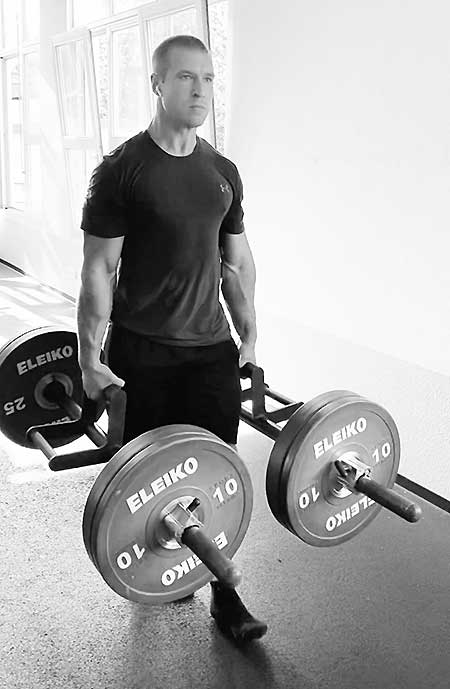
I followed this structure for three and a half months, from June 2021 until the end of September, when I assisted at the SFL Instructor Certification in Paris and finally had the chance to meet and learn from Jason in person. One of my big take-aways was adjusting your deadlift stance based on your hip structure. Hearing Jason explain that the best stance width for a person depends almost completely on their hip anatomy encouraged me to try something I thought about for a long time. Since a narrow sumo stance is the stance I tend to use for Zercher Squats and most kettlebell ballistics, I always thought that this might be a strong position for me. It would also more closely resemble the stance I was planning on using to lift the Dinnie Stones.
After returning home from the SFL, I wanted to see how the narrow sumo stance felt. I started working up in the rack pull with the goal of reaching a “comfortable heavy stop.” I was surprised, to say the least, when 280kg “flew” up. 285kg went up fairly easily followed by 290kg. I started getting excited. Could 300kg be within reach? However, when attempting 295kg I started twisting midway and couldn’t finish the lift. Nevertheless, I was quite astonished by the immense effect of this small change.
Phase 2: Specific Physical Preparedness 1–Never Change a Running Plan
With an optimized technique and a new 1RM (one rep max) in the rack pull, I decided to make some adjustments to the program. Keeping the basic outline that worked so well until now, I added a new linear cycle for the rack pull. Together with Jason, we decided on a conservative progression that would allow me to build up momentum. I started with 70% (205kg) in week one and increased the weight from week to week by 5%. This resulted in an 8-week cycle.
I also reduced the variability regarding the amount of training days to establish a rhythm. As Pavel and Fabio explained at Programming Improv, this strategy gives your body an anticipation for lifting heavy and an expectation of high performance on a specific day. An example of this would be the “5-week TSC deadlift plan” where Pavel employed the same tactic to prime an athlete for a deadlift PR on the day of the competition. Knowing my weekly rhythm, I decided to do the heavy rack pulls on Tuesday (not knowing at this point that my appointment for lifting the Dinnie Stones would be on a Tuesday afternoon).
Also, I added swings as assistance exercise for the rack pull since they train the same muscles as heavy pulls but are easier to recover from. This strategy worked well for high-class powerlifters like Andy Bolton and Donnie Thompson.
Following the recommendations for swings as assistance work by StrongFirst Certified Master Emeritus, Mark Reifkind in Deadlift Dynamite, I chose dead-stop swings and one-arm swings:
- Dead-stop swings with a focus on a fast and powerful acceleration to balance the slower and heavier Zercher squats on Monday and Thursday and to build starting strength.
- One-arm swings to complement the pulls on Tuesday and Friday, counterbalancing their lack of eccentric loading, strengthening the grip and lats, and adding an anti-rotation component. This aided greatly in spinal stabilization—an important aspect for lifting the Dinnie Stones. The two stones differ in both weight and height, which puts an enormous demand on spinal stabilization.
To round everything off, I alternated get-ups and farmer walks on Monday and Thursday, as well as renegade rows on Tuesday and Friday.
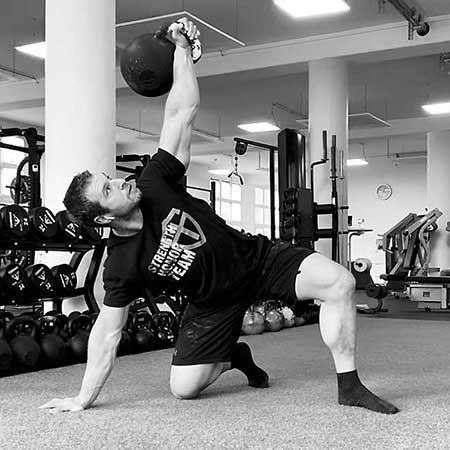
This is how my program looked at this point:
After eight weeks, I reached my first sub goal on December 14th of 2021: a rack pull of 300kg.
With this achieved, I reached out to Stevie Shanks to schedule the date of my attempt: Tuesday, July 19th, 2022.
Phase 3: Specific Physical Preparedness 2—The Final Step
In the last phase of my preparation (or so I thought, but more about that in a second) I added a final element: specificity. Switching from rack pulls to pulls with loading pins and imitations of the Dinnie Handles to transfer the strength built over the last months to the feat itself.
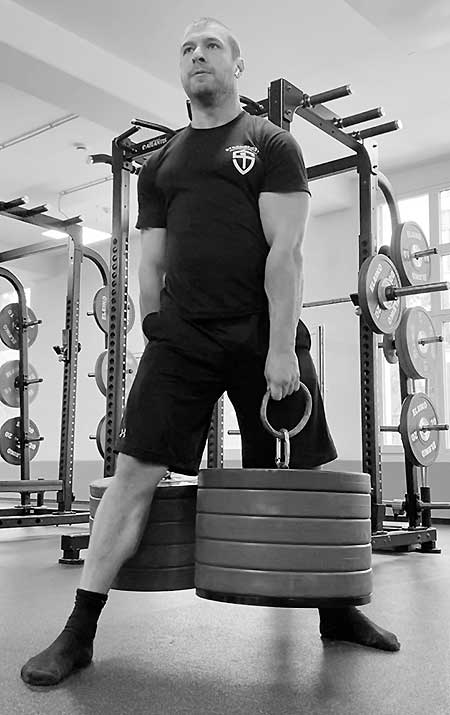
In “Science and Practice of Strength Training,”1 the authors make the important point that “[t]he higher an athlete’s level of fitness, the more specific the adaptation” and the “more specific exercises and training methods to increase competitive preparedness” should become. They describe specificity as “an issue of transfer of training results” and the need to make training more and more specific the closer to a competition you get because “[t]he transfer of training gains can differ greatly even in very similar exercises.”
Following John Odden’s recommendation, I used an “Easy Strength” approach to build confidence and get more familiar with the pins. I “practiced” twice a week on Tuesday and Friday in sets of 2-3 reps for a total of 10-15 reps.
After several weeks of familiarizing myself with them, I integrated the pin pulls into my program just as I had with rack pulls:
- Tuesday—heavy day: 6 singles on Tuesday, working up to a daily heavy top set.
- Friday—light day: Several sets of 1-3 reps for a total of 10-15 reps on Friday, staying within 70-85% of my 1RM.
Since there was more than enough time until my journey to Scotland, I did not lay out a linear cycle as I did with the rack pull. Instead, I decided to take a slower, more intuitive approach, granting my body enough time to adapt to the new stressors presented by the lifting pins.
I knew that building the necessary muscular strength would happen relatively fast, but due to the asymmetrical position and loading of the spine, I wanted to make sure my ligaments, tendons, and bones would have the necessary time to adapt as well. In addition, despite more than a decade of training with kettlebells and barbells, my hands were not used to the friction caused by the imitation handles. Preventing my skin from tearing turned out to become a bigger challenge than developing the necessary grip strength.
Following this schedule, I successfully lifted the full weight of the Dinnie Stones in training on February 24th, 2022.
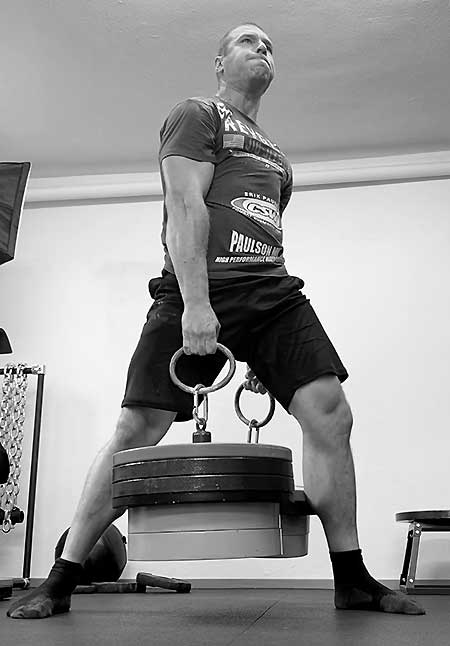
Having lifted the full weight of the Dinnie Stones that early before facing them in July gave me reassurance. Nevertheless, I wanted to work up to a weight about 5-10% heavier than the Stones to have a strength reserve. My plan was to stay with this program until my trip to Scotland. But so often in life, things seldom go as we envision them.
Phase 4: Adapt and Overcome
At the beginning of 2022, I made the major life decision to go back to school and earn my physiotherapy degree. But instead of starting in October as I originally planned, I was offered—and accepted—the possibility to start in April. This threw off the whole plan I had for that year and changed my situation completely. With a different weekly schedule and no gym available, I had to adapt my training accordingly.
Knowing that I would have to make compromises, I took stock of my resources and ordered my priorities. My main concern was maintaining the continuity of the overall training process. Major changes in life circumstances all too often (and understandably) carry the danger of losing sight of training. For me, having a wide range of kettlebells available at home and focusing on the broad effects offered by “power as a multi-purpose load” as well as kettlebell training in particular mitigated this problem quite a bit.
Within the big picture, the most important consideration was continuing the heavy pulls since my trip to Scotland was only three months out. Thankfully, a friend offered me the opportunity to lift at his small private gym once a week on Tuesday afternoon. This forced me to get used to lifting heavy later in the day—perfect for preparing for my attempt.
As Pavel explains in the article, “Q&D + Minimalist Deadlifts,” you can get away with a minimum of heavy pulls once a week if you plan and execute your kettlebell ballistics with a focus on power development targeting fast twitch muscle fibers. All you need is “an occasional barbell pull to translate the gains made with your ballistics.” This proven combination became the core of my training.
Additionally, I joined a smaller gym to have access to a barbell and add a few assistance exercises.
This is the general outline of my training program during the last four months leading up to my attempt:
With this approach, I was able to strongly lift 352.5kg (about 105% of the Dinnie Stones’ weight) with the lifting pins and imitation handles one week before my attempt in Scotland.
Conclusion—Always Learning
Writing this article and mentally going through the whole training process again was very enlightening. What looks like a linear and coherent process in retrospect was something that happened naturally and intuitively. Certain adjustments felt “just right” at the given time or were “forced” by circumstances, and I had to make them work. The classifications of GPP, SPP1, and SPP2 for example were added in retrospect, because I noticed that they closely fit the stages of my program.
Seeing all the parts of the program laid out the big picture. I realized that a lot of things that seemed like planned or purposefully taken next steps were done intuitively. For example, during the two SPP phases, I had the tendency to build up intensity at the beginning of the week, “peak” in the middle, and then drop intensity towards the end. This gradual buildup of volume from the beginning to the end of the week is also often used in Plan Strong and Built Strong.
Thinking about all this more deeply, I realize programs that deliver the best results for me have certain guidelines and frameworks but allow me to move freely inside these boundaries and adapt things as necessary. Through these programs, I learned a lot about my rate of adaptation and how to structure the training process accordingly.
To paraphrase Dan John: Ultimately, it’s not about the program, it’s about what you learn about yourself.
Please enjoy this conversation between StrongFirst Certified Master Instructor Jason Marshall and
StrongFirst Certified Instructor John Odden discussing their Dinnie Stones lifting experience.
References
1Zat͡siorskiĭ V. M., William J. Kraemer, and Andrew C. Fry. Science and Practice of Strength Training. Thirded. Champaign, IL: Human Kinetics, 2021.
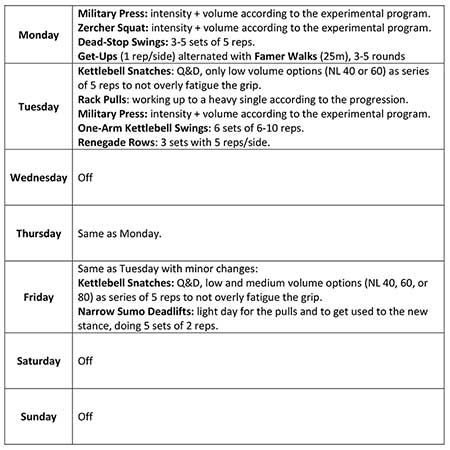
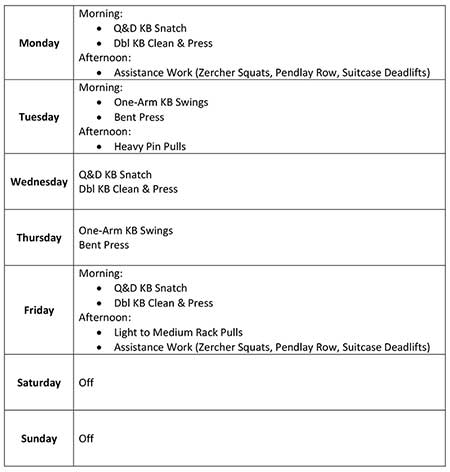

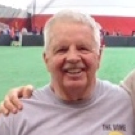

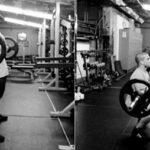
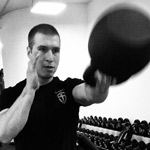

I lifted dinnies in 2019 and funny enough used another Pavel program…PTTP. Was literally all I did for 3 months. Worked great and at a bodyweight of only 70kg
Good luck in school
Sven, congratulations!
The rings and loading pins we see in the pictures, e.g., https://www.strongfirst.com/wordpress/wp-content/uploads/2023/04/sven-dinnie-handles-03.jpg – can you give links to the specifications or where one might find things to train for this lift?
Thank you.
Hey Steve!
Thank you, and good question, since I didn’t mention anything about this in the articles.
I got the Dinnie Imitation Handles from Rogue – not knowing that although they have the same size as the original handles of the Stones, they are thinner in diameter and have a rougher surface (which is why I had so much trouble with my hands during training).
The pins were done by a friend of mine, because a) at that time, loading pins were sold out at every and b) because I needed two different heights to replicate the condition of the Stones. Some companies, like Rogue, offer loading pins that are adjustable in height, so this is a factor that’s important to consider.
That being said, Cerberus Strength and Killer Strength Scotland not only offer imitation handles that are basically exact replicas of the original handle (size, diameter, surface) and way easier (but still not comfortable) on the hands than the ones from Rogue, but complete “Dinnie Stones” sets – handles and pins.
Best most accurate rings I know of are from the guys in Scotland…’killerstrengthscotland’ and ‘gordon j Ingram’. Their rings are based on the actual height from ground along with the peculiarities and defects of handle
Stuart, I found what you’ll see at the link below at one of the sites you mention, and asked for them for Father’s Day which means I’ll have them in a couple of weeks.
https://cerberus-strength.us/products/cerberus-dinnie-stone-handles
I’m about your size, usually 69 kg and compete in powerlifting at 67.5, and I’m 68 years young. About 10 years ago, I managed a hip lift (in the USAWA) of over 1000 lbs, so I think there may be some hope for me here.
Congratulations. Excellent article.
Thank you José!
Thanks for these incredible insights, Sven!
It’s hard to realize how much hard work has been put into this endeavour. Not only was the work hard, but also super smart and painstakingly calculated!
Congratulations again!
Hey Matthieu!
Thank you very much!
Just seen your comment Steve. The Cerberus rings look decent. Good luck in your lift. At your weight and age that’ll be unreal
Very cool article! Thank you so much for this – so true that the specificity of training must be matched by life’s vagaries and daily “feel.” Great stuff 🙂
Thank you Meghan! I am happy that you enjoyed it!